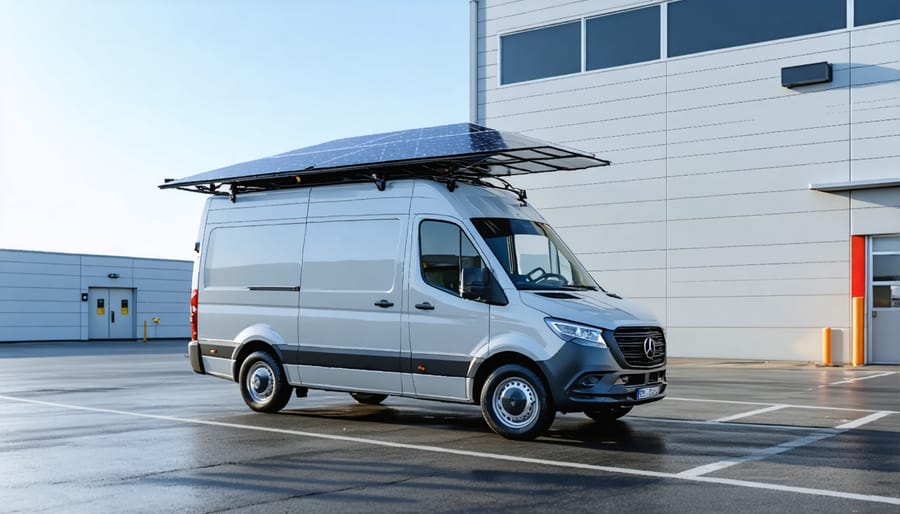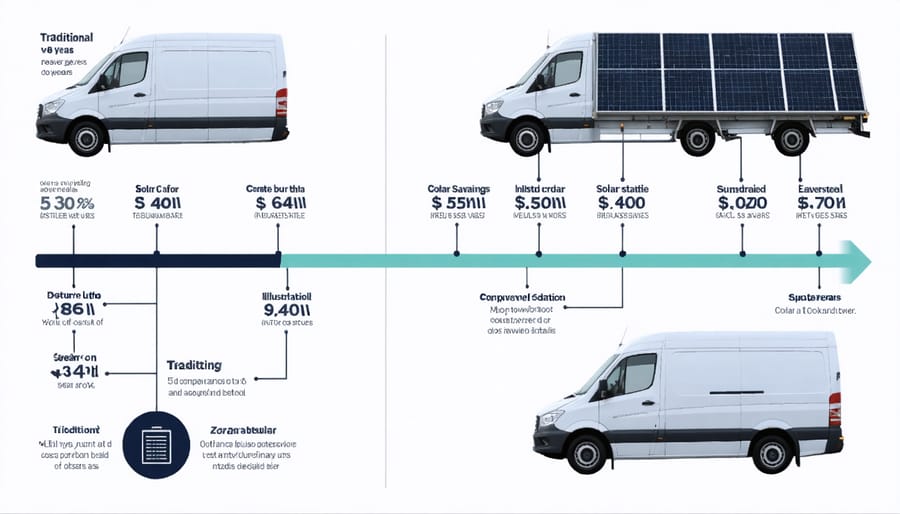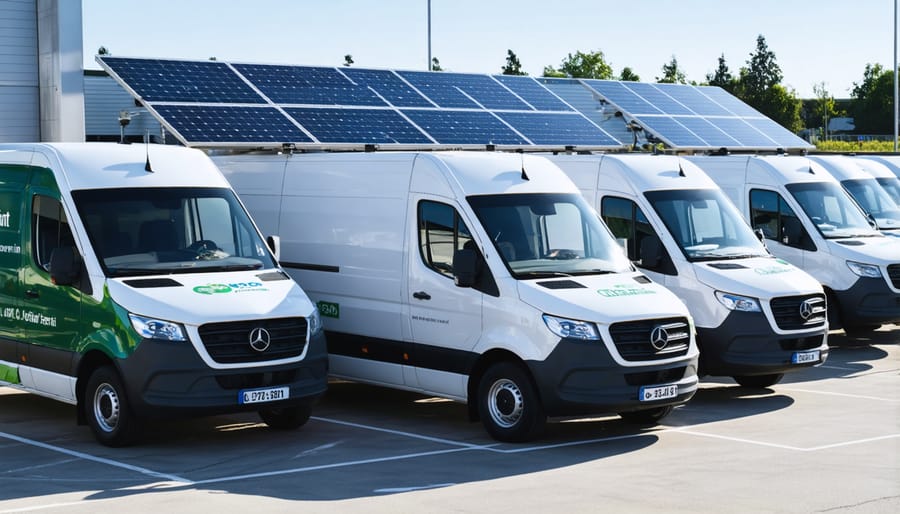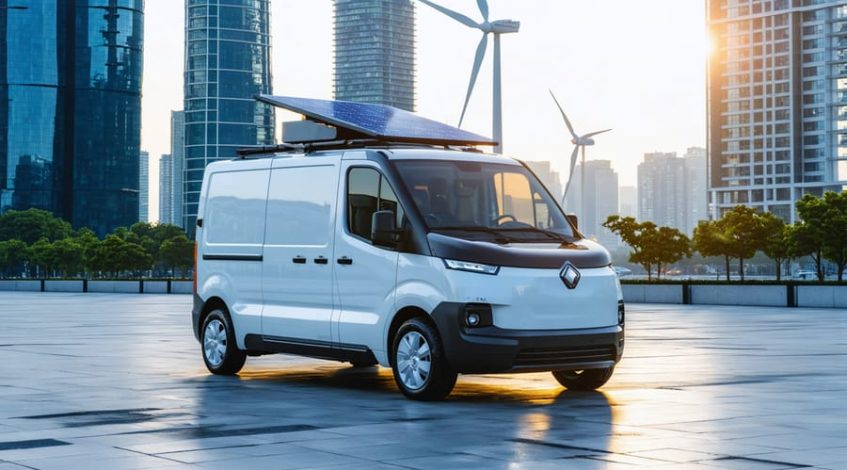Solar-powered vans represent a transformative leap in sustainable city mobility, offering businesses a compelling fusion of operational efficiency and environmental responsibility. As fuel costs continue to rise and environmental regulations tighten, these innovative vehicles deliver up to 70% reduction in operational expenses while extending range capabilities by 15-25 miles per day through integrated solar technology. Leading companies across Europe and North America have already deployed solar-powered van fleets, reporting significant improvements in both sustainability metrics and bottom-line performance. The integration of high-efficiency photovoltaic panels, smart energy management systems, and regenerative braking technologies has created a new paradigm in commercial transportation, particularly suited for last-mile delivery services and mobile business operations. This advancement not only addresses the growing demand for zero-emission vehicles but also provides a practical solution for businesses seeking to future-proof their transportation infrastructure while maintaining operational reliability and cost-effectiveness.
The Technology Behind Solar-Powered Vans
Advanced Solar Panel Integration
Modern solar-powered vans utilize advanced photovoltaic systems specifically engineered for vehicular applications. These systems typically incorporate flexible thin-film solar panels that conform to the van’s roof curvature, maximizing the available surface area while maintaining aerodynamic efficiency. High-efficiency monocrystalline panels, ranging from 300W to 800W per panel, are strategically positioned to optimize energy capture during both stationary and mobile operations.
The integration process involves installing a comprehensive power management system that includes MPPT (Maximum Power Point Tracking) charge controllers, specialized inverters, and smart battery systems. These components work in tandem to ensure optimal power conversion and storage efficiency, typically achieving conversion rates of 20-25% under ideal conditions.
Leading manufacturers now offer pre-configured solar kits designed specifically for commercial vans, featuring plug-and-play connections and reinforced mounting systems that withstand vibration and varied weather conditions. These systems commonly include:
– Lightweight aluminum mounting frames with aerodynamic profiles
– Marine-grade wiring systems with UV-resistant protection
– Intelligent power distribution units with remote monitoring capabilities
– Hybrid charge controllers that accommodate both solar and alternator charging
Recent innovations include bifacial panels that can capture reflected light from the ground, increasing energy yield by up to 10% in certain conditions. Additionally, smart monitoring systems provide real-time performance data and predictive maintenance alerts, enabling fleet managers to optimize their solar-powered vehicle operations effectively.

Energy Storage and Management Systems
The heart of a solar-powered van’s efficiency lies in its advanced energy storage and management systems. Modern lithium-ion battery technologies, specifically designed for mobile applications, provide the foundation for reliable energy storage. These systems typically feature capacities ranging from 40kWh to 100kWh, depending on the van’s size and intended use.
Smart power management systems optimize energy distribution between solar input, battery storage, and vehicle operations. These systems employ sophisticated algorithms to balance power consumption across different components while maintaining optimal battery health. Real-time monitoring capabilities allow operators to track energy production, consumption, and storage levels through user-friendly interfaces.
Most solar-powered vans incorporate dual-charging capabilities, enabling both solar charging and traditional grid charging when needed. The battery management system (BMS) ensures safe charging parameters, monitors cell temperatures, and prevents overcharging or deep discharging, extending battery life significantly.
Energy recovery systems, including regenerative braking, contribute to overall efficiency by capturing and storing energy that would otherwise be lost. Advanced thermal management systems maintain optimal battery temperature ranges, crucial for battery longevity and performance in varying climate conditions.
For commercial applications, these systems typically offer a service life of 8-10 years, with many manufacturers providing warranties covering up to 80% of original capacity retention. The integration of smart grid capabilities allows for potential vehicle-to-grid (V2G) applications, creating additional value streams for fleet operators.
Commercial Benefits and ROI Analysis
Operating Cost Reduction
The economic impact of solar-powered vans is most evident in their substantial operating cost reduction potential. Analysis of fleet operations shows that businesses can reduce fuel costs by 70-80% when transitioning from conventional diesel vans to solar-powered alternatives. A typical commercial van covering 50,000 kilometers annually can save approximately $4,500-$6,000 in fuel costs alone.
Maintenance costs also decrease significantly due to the simplified powertrain of electric vehicles enhanced with solar technology. With fewer moving parts and reduced mechanical complexity, maintenance expenses can be cut by up to 40% compared to traditional combustion engine vehicles. Oil changes, transmission services, and exhaust system repairs become obsolete, resulting in annual savings of $1,200-$1,800 per vehicle.
Battery life extension through solar charging further contributes to cost reduction. Solar panels can extend the primary battery’s lifespan by 20-25% by reducing the frequency of deep discharge cycles. This translates to approximately $3,000-$4,000 in savings over the vehicle’s lifetime through delayed battery replacement requirements.
Real-world implementation data from European fleet operators demonstrates that the total operating cost reduction can reach 60% when combining fuel savings, reduced maintenance, and extended component life. For a fleet of 10 vans, this represents annual savings of $75,000-$90,000, with additional benefits from government incentives and carbon credit programs. These figures underscore the compelling business case for solar-powered van adoption in commercial operations.

Environmental Compliance and Incentives
Solar-powered vans operate within an increasingly supportive regulatory framework, with numerous government incentives available to accelerate adoption. In the European Union, the Clean Vehicle Directive mandates that 45% of light commercial vehicles procured by public bodies must be clean vehicles by 2025, making solar-powered vans an attractive option for compliance.
Business owners can benefit from various financial incentives, including tax credits, grants, and accelerated depreciation schemes. The EU’s Recovery and Resilience Facility provides substantial funding for green mobility initiatives, while individual member states offer additional support. For instance, Germany’s “Innovation Premium” provides up to €9,000 for electric vehicle purchases, including solar-powered vans.
Environmental regulations increasingly favor zero-emission vehicles in urban areas. Low Emission Zones (LEZs) and Ultra Low Emission Zones (ULEZs) in major European cities exempt solar-powered vans from access restrictions and charges. This regulatory advantage translates into operational cost savings and enhanced business opportunities in restricted urban areas.
Carbon credit trading schemes present another economic opportunity. Organizations operating solar-powered van fleets can generate carbon credits, which can be traded on established markets or used to offset emissions from other operations. The value of these credits continues to rise as carbon markets mature.
For compliance tracking, fleet operators must maintain detailed documentation of their vehicles’ environmental performance. Modern solar-powered vans typically come equipped with monitoring systems that generate the necessary data for regulatory reporting and incentive applications, streamlining the administrative process while ensuring full compliance with environmental regulations.
Real-World Implementation Case Studies
Delivery Services Success Story
GreenDelivery Co., a mid-sized logistics company operating in metropolitan areas, successfully transformed their delivery fleet with solar-powered vans, demonstrating the practical benefits of this technology. In 2021, they initiated a pilot program by converting 10 of their conventional delivery vans to solar-hybrid vehicles equipped with roof-mounted photovoltaic panels.
The results were remarkable: fuel consumption decreased by 38% across their converted fleet, while delivery capacity remained unchanged. The solar panels, generating an average of 12 kWh per day during peak sunlight hours, effectively powered the vehicles’ refrigeration units and auxiliary systems, reducing the strain on the main engine.
Cost analysis revealed significant savings. The initial investment of €15,000 per van conversion was offset within 18 months through reduced fuel costs and lower maintenance requirements. Additionally, the company reported a 42% reduction in carbon emissions, strengthening their position in environmentally conscious markets.
Driver feedback highlighted improved comfort due to solar-powered climate control systems that operate without engine idling. The company also noted enhanced reliability, with zero solar system failures during the first year of operation.
Following this success, GreenDelivery Co. has committed to converting their entire fleet of 50 vehicles by 2025. Their experience demonstrates that solar-powered vans are not just environmentally responsible but also commercially viable for modern delivery operations.

Municipal Fleet Integration
Several municipalities worldwide have successfully integrated solar-powered vans into their fleets, demonstrating the viability of sustainable transport solutions in public services. A notable example is the City of Amsterdam’s initiative, which deployed 50 solar-enhanced electric delivery vans across various municipal departments in 2022, resulting in a 35% reduction in operational costs and a 40% decrease in carbon emissions.
The integration process typically begins with a pilot program, allowing cities to evaluate performance metrics and adjust implementation strategies. For instance, Barcelona’s municipal fleet incorporated 25 solar vans for postal services, integrating them seamlessly with existing urban transportation infrastructure. The program demonstrated a 28% increase in operational range compared to standard electric vans.
Key success factors include strategic charging station placement, comprehensive driver training programs, and data-driven maintenance schedules. Melbourne’s municipal fleet achieved an 80% utilization rate by implementing smart fleet management systems that optimize route planning and solar charging cycles. The city reported annual savings of AUD 120,000 per vehicle in fuel and maintenance costs.
These implementations have created blueprints for other municipalities, establishing best practices for fleet transition strategies. Most successful programs begin with detailed feasibility studies, followed by phased implementation plans that allow for systematic evaluation and optimization of vehicle performance.
Implementation Guidelines
Fleet Assessment and Planning
Transitioning to solar-powered vans requires careful assessment of existing fleet operations and development of a comprehensive implementation strategy. Organizations should begin by analyzing their current vehicle usage patterns, including daily mileage, charging window opportunities, and payload requirements. This data forms the foundation for determining the feasibility of public transport fleet solutions and optimal solar integration.
Key assessment criteria include:
– Route predictability and consistency
– Average daily sunlight exposure
– Available parking infrastructure for charging
– Current fuel and maintenance costs
– Vehicle replacement schedules
– Operational requirements and limitations
Successful fleet transition plans typically follow a phased approach, starting with pilot programs of 2-3 vehicles to validate performance and ROI calculations. Organizations should establish clear metrics for success, including cost savings, emissions reduction, and operational efficiency improvements. This data helps refine implementation strategies and secure stakeholder buy-in for larger-scale adoption.
Infrastructure planning is crucial, encompassing charging stations, maintenance facilities, and staff training programs. Fleet managers should also consider seasonal variations in solar generation and plan for supplementary charging solutions during periods of reduced sunlight. Partnership with experienced solar providers ensures proper system sizing and integration while maximizing return on investment through available incentives and grants.
Maintenance and Support Requirements
Regular maintenance of solar-powered vans is essential for optimal performance and longevity. The primary maintenance requirements focus on two key components: the solar system and the vehicle itself. The solar panels require quarterly cleaning to remove dust, debris, and bird droppings that can reduce efficiency. An annual professional inspection of the panels, inverters, and electrical connections ensures system integrity and peak performance.
Battery maintenance is crucial, with bi-annual checks of charge controllers, connections, and overall battery health recommended. Modern lithium-ion batteries typically require less maintenance than traditional lead-acid alternatives but should still be monitored through the van’s battery management system (BMS).
The vehicle’s mechanical components need standard automotive maintenance, with additional attention to the weight distribution and roof-mounted equipment. Regular checks of panel mounting brackets and weather sealing are essential to prevent water ingress and maintain structural integrity.
Support systems should include remote monitoring capabilities to track energy production, consumption, and system health. Many fleet operators implement preventive maintenance schedules that combine both solar and vehicle maintenance tasks. It’s recommended to partner with certified solar technicians and automotive specialists familiar with electric vehicle systems.
Emergency support protocols should be established, including access to mobile repair services and backup power solutions. Documentation of maintenance activities and system performance helps optimize operational efficiency and extends the system’s lifespan.
Solar-powered vans represent a significant leap forward in sustainable commercial transportation, offering businesses a practical solution to reduce operational costs while meeting environmental objectives. The technology has proven its viability through successful implementations across various sectors, from delivery services to mobile businesses. As battery technology continues to advance and solar panel efficiency improves, we can expect to see wider adoption of these vehicles in commercial fleets. The future outlook is particularly promising, with projections indicating a 30% reduction in total ownership costs over traditional vehicles within the next five years. For businesses looking to future-proof their operations and maintain competitive advantage, solar-powered vans offer a compelling combination of environmental responsibility and economic benefits. With supportive government policies and increasing market demand for sustainable solutions, solar-powered vans are positioned to become a standard feature in commercial transportation infrastructure.

